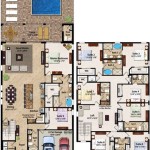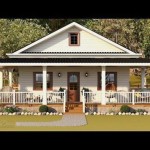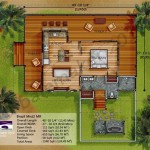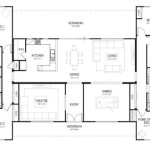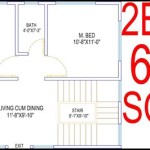Tudor style house plans are blueprints used for constructing or renovating houses in the distinctive architectural style of the Tudor period, which spanned from the late 15th to early 17th centuries in England. These plans are widely popular among homeowners who desire a charming historical aesthetic in their residences.
Tudor style houses are characterized by their steeply pitched roofs, prominent chimneys, decorative half-timbering, and large bay windows. They often feature a combination of brick, stone, and wood in their construction, resulting in a timeless and visually appealing appearance. In contemporary architecture, Tudor style house plans have become increasingly sought-after due to their enduring charm and adaptability to modern design elements.
In this article, we will delve into the intricate details of Tudor style house plans, exploring their history, architectural features, and the advantages and disadvantages of building a Tudor-style home. We will showcase stunning examples and provide practical guidance to assist homeowners in creating their dream Tudor-inspired residence.
To fully grasp the Tudor style, it’s essential to consider its key characteristics. Here are nine significant points to remember:
- Steeply pitched roofs
- Prominent chimneys
- Decorative half-timbering
- Large bay windows
- Combination of brick, stone, and wood
- Asymmetrical facades
- Leaded glass windows
- Ornate doorways
- Intricate interior details
Understanding these elements will provide a solid foundation for exploring Tudor style house plans and creating a home that embodies the timeless charm of this architectural style.
Steeply pitched roofs
Steeply pitched roofs are a defining characteristic of Tudor style house plans. These roofs provide several advantages that enhance the functionality and aesthetic appeal of Tudor homes:
- Protection from the elements: The steep pitch of the roof allows water and snow to shed quickly and efficiently, preventing leaks and damage to the structure. This is particularly important in regions with heavy rainfall or snowfall.
- Increased headroom: The steeply pitched roof creates more headroom in the upper floors of the house, making the rooms feel more spacious and airy. This is especially beneficial in bedrooms and other living areas.
- Improved ventilation: The steep pitch of the roof promotes natural ventilation by allowing warm air to rise and escape through the roof vents. This helps to keep the house cool and comfortable during warm weather.
- Enhanced curb appeal: The steeply pitched roof adds a dramatic and visually appealing element to the exterior of the house. It creates a sense of height and grandeur, making the home stand out from neighboring properties.
Overall, the steeply pitched roof is an essential element of Tudor style house plans, providing both functional and aesthetic benefits that contribute to the enduring popularity of this architectural style.
Prominent chimneys
Prominent chimneys are another defining feature of Tudor style house plans. These chimneys serve both functional and aesthetic purposes, contributing to the overall charm and historical accuracy of Tudor-inspired homes.
- Enhanced ventilation: Tudor-style chimneys are designed to efficiently draw smoke and fumes out of the house, ensuring proper ventilation and air quality. This is especially important in homes that use fireplaces or wood-burning stoves as a primary source of heat.
- Improved structural stability: The large chimneys act as structural supports, reinforcing the walls and roof of the house. This is particularly important in regions prone to strong winds or earthquakes.
- Increased curb appeal: The prominent chimneys add a distinctive and visually appealing element to the exterior of the house. They create a sense of height and grandeur, making the home stand out from neighboring properties.
- Historical accuracy: Tudor-style chimneys are an essential element in recreating the authentic look and feel of Tudor-era architecture. They provide a tangible connection to the past, adding historical charm and character to the home.
Overall, the prominent chimneys in Tudor style house plans serve multiple purposes, enhancing both the functionality and aesthetic appeal of the home. They contribute to proper ventilation, improve structural stability, increase curb appeal, and provide historical authenticity.
Decorative half-timbering
Decorative half-timbering is a distinctive architectural feature that adds visual interest and historical charm to Tudor style house plans. It involves the use of exposed wooden beams and studs to create a decorative framework on the exterior walls of the house.
- Structural support: Half-timbering originally served a structural purpose, providing support to the walls of the house. The beams and studs were load-bearing elements that helped to distribute weight and ensure the stability of the structure.
- Aesthetic appeal: In Tudor style house plans, half-timbering has evolved into a primarily decorative element. The exposed wooden beams create a visually appealing pattern on the exterior of the house, adding depth and character. The contrast between the light-colored beams and the darker infill panels creates a striking and eye-catching effect.
- Historical accuracy: Half-timbering is an essential element in recreating the authentic look and feel of Tudor-era architecture. It provides a tangible connection to the past, adding historical charm and character to the home.
- Variety of styles: Decorative half-timbering can be customized to suit different tastes and preferences. The beams and studs can be arranged in various patterns, and the infill panels can be filled with a variety of materials, such as brick, stone, or plaster. This allows homeowners to create a unique and personalized look for their Tudor-style home.
Overall, decorative half-timbering in Tudor style house plans serves both aesthetic and historical purposes. It adds visual interest and character to the exterior of the home, while also providing a tangible connection to the architectural traditions of the Tudor period.
Large bay windows
Large bay windows are a signature feature of Tudor style house plans, adding both aesthetic appeal and functional benefits to the home.
- Increased natural light: Bay windows project outward from the main wall of the house, creating a larger window area that allows more natural light to enter the room. This can brighten up the interior space, making it feel more inviting and cheerful.
- Improved views: Bay windows provide panoramic views of the surrounding landscape, allowing homeowners to enjoy the outdoors from the comfort of their own home. This is especially beneficial in homes with scenic views or in areas with limited outdoor space.
- Enhanced ventilation: Bay windows can be opened to allow fresh air to circulate throughout the room. This can help to improve air quality and create a more comfortable living environment.
- Increased space: Bay windows create a small alcove or nook within the room, which can be used for a variety of purposes, such as a reading area, a cozy seating area, or a small home office.
Overall, large bay windows in Tudor style house plans offer a range of advantages, including increased natural light, improved views, enhanced ventilation, and increased space. They add both aesthetic charm and functional benefits to the home, making them a popular choice among homeowners who desire a touch of Tudor-inspired elegance in their living spaces.
Combination of brick, stone, and wood
Tudor style house plans are characterized by their distinctive use of a combination of brick, stone, and wood in their construction. This combination of materials creates a visually appealing and historically accurate exterior that is reminiscent of the Tudor period in English history.
Brick: Brick is a common material used in Tudor style house plans, particularly in the lower levels of the home. It provides a sturdy and durable exterior that can withstand the elements. Brick is also fire-resistant, making it a safe choice for homes in areas prone to wildfires.
Stone: Stone is another popular material used in Tudor style house plans, often in combination with brick. Stone adds a touch of elegance and sophistication to the home’s exterior. It is a durable material that can last for centuries, making it a worthwhile investment for homeowners who desire a timeless look for their home.
Wood: Wood is primarily used in Tudor style house plans for the half-timbering, which is a decorative framework of exposed wooden beams and studs. Half-timbering adds visual interest and character to the home’s exterior. It is also a structural element that helps to support the walls of the house.
Overall, the combination of brick, stone, and wood in Tudor style house plans creates a visually appealing and historically accurate exterior that is both durable and charming. These materials have stood the test of time and continue to be popular choices for homeowners who desire a touch of Tudor-inspired elegance in their homes.
Asymmetrical facades
Asymmetrical facades are a defining characteristic of Tudor style house plans. This means that the front of the house is not symmetrical, with one side being different from the other. This asymmetry creates a sense of visual interest and dynamism that is reminiscent of the architectural styles of the Tudor period.
- Varying rooflines: Tudor style house plans often feature varying rooflines, with one side of the house having a different roof pitch or shape than the other. This asymmetry adds visual interest and complexity to the exterior of the home.
- Off-center entrances: The front entrance of a Tudor style house is often off-center, creating a sense of asymmetry. This off-center placement can be further emphasized by the use of a grand porch or doorway on one side of the house.
- Multiple gables: Tudor style house plans often incorporate multiple gables into the design of the facade. These gables can be of different sizes and shapes, adding visual interest and depth to the exterior of the home.
- Combination of materials: Tudor style house plans often use a combination of materials, such as brick, stone, and wood, to create a visually appealing and asymmetrical facade. The use of different materials can highlight different elements of the design, such as the half-timbering or the bay windows.
Overall, the asymmetrical facades of Tudor style house plans create a sense of visual interest and dynamism that is both historically accurate and aesthetically pleasing. This asymmetry is achieved through varying rooflines, off-center entrances, multiple gables, and a combination of materials, resulting in a unique and charming exterior design.
Leaded glass windows
Leaded glass windows are a distinctive feature of Tudor style house plans, adding a touch of elegance and historical charm to the home. These windows are characterized by the use of small panes of glass held together by lead came, creating a unique and eye-catching appearance.
- Enhanced aesthetics: Leaded glass windows add a touch of sophistication and elegance to the exterior of a Tudor-style home. The intricate patterns and colors of the glass create a visually appealing and unique look that sets the home apart from others.
- Historical accuracy: Leaded glass windows were commonly used in Tudor-era architecture. By incorporating these windows into a modern home, homeowners can create a sense of historical authenticity and charm.
- Natural light: Leaded glass windows allow ample natural light to enter the home while maintaining privacy. The small panes of glass diffuse the light, creating a soft and inviting atmosphere.
- Energy efficiency: Modern leaded glass windows are designed to be energy-efficient, featuring double or triple glazing to reduce heat loss. This can help homeowners save on energy costs while enjoying the beauty of leaded glass windows.
Overall, leaded glass windows are an essential element of Tudor style house plans, providing both aesthetic appeal and historical accuracy. They add a touch of elegance and charm to the home while also allowing for ample natural light and energy efficiency.
Ornate doorways
Ornate doorways are a hallmark of Tudor style house plans, adding a touch of grandeur and historical charm to the home’s exterior. These doorways are characterized by their intricate carvings, decorative moldings, and elaborate hardware, creating a visually stunning and welcoming entrance.
Historical accuracy: Ornate doorways were a common feature in Tudor-era architecture. By incorporating these doorways into a modern home, homeowners can create a sense of historical authenticity and charm. The intricate carvings and moldings reflect the craftsmanship and artistry of the Tudor period.
Aesthetic appeal: Ornate doorways add a touch of elegance and sophistication to the exterior of a Tudor-style home. The elaborate designs and decorative hardware create a visually appealing focal point that draws the eye and sets the home apart from others. The carvings and moldings can depict a variety of motifs, such as heraldic symbols, floral patterns, or religious scenes.
Customization: Ornate doorways offer a high degree of customization, allowing homeowners to create a unique and personalized entrance to their home. The carvings, moldings, and hardware can be tailored to suit individual tastes and preferences. Homeowners can choose from a wide range of designs, from simple and elegant to highly elaborate and ornate.
Overall, ornate doorways are an essential element of Tudor style house plans, providing both aesthetic appeal and historical accuracy. They add a touch of grandeur and elegance to the home’s exterior, while also offering a high degree of customization to create a unique and personalized entrance.
Intricate interior details
Tudor style house plans are renowned for their intricate interior details that evoke the charm and elegance of the Tudor period. These details are meticulously incorporated into various elements of the home’s interior, creating a cohesive and visually stunning living space.
Elaborate moldings and carvings: Tudor style house plans often feature elaborate moldings and carvings throughout the interior. These decorative elements add depth and character to the walls, ceilings, and doorways. Intricate moldings can be found around fireplaces, windows, and doorways, while carved panels and friezes often adorn ceilings and walls. These details create a sense of grandeur and historical authenticity, reminiscent of the grand halls and chambers of Tudor-era castles and manor houses.
Ornate fireplaces: Fireplaces are a central feature in many Tudor style homes. In keeping with the elaborate style, Tudor fireplaces are often adorned with intricate carvings, decorative tiles, and grand mantels. The mantels may feature heraldic symbols, floral motifs, or religious scenes, adding a touch of historical charm and visual interest to the room. The fireplaces serve as a focal point, creating a warm and inviting atmosphere in the home.
Exposed beams and timbers: Exposed beams and timbers are another characteristic feature of Tudor style house plans. These structural elements are left visible, adding a rustic and authentic touch to the interior. The beams and timbers may be made of oak or other hardwoods and can be arranged in a variety of patterns. They not only provide structural support but also create a sense of warmth and coziness, reminiscent of traditional Tudor dwellings.
Overall, the intricate interior details found in Tudor style house plans contribute to the home’s historical charm and visual appeal. These details, ranging from elaborate moldings and carvings to ornate fireplaces and exposed beams, create a cohesive and authentic living space that evokes the grandeur and elegance of the Tudor period.










Related Posts

